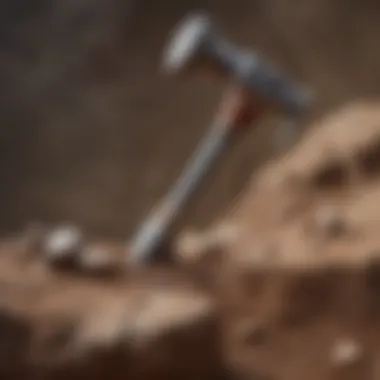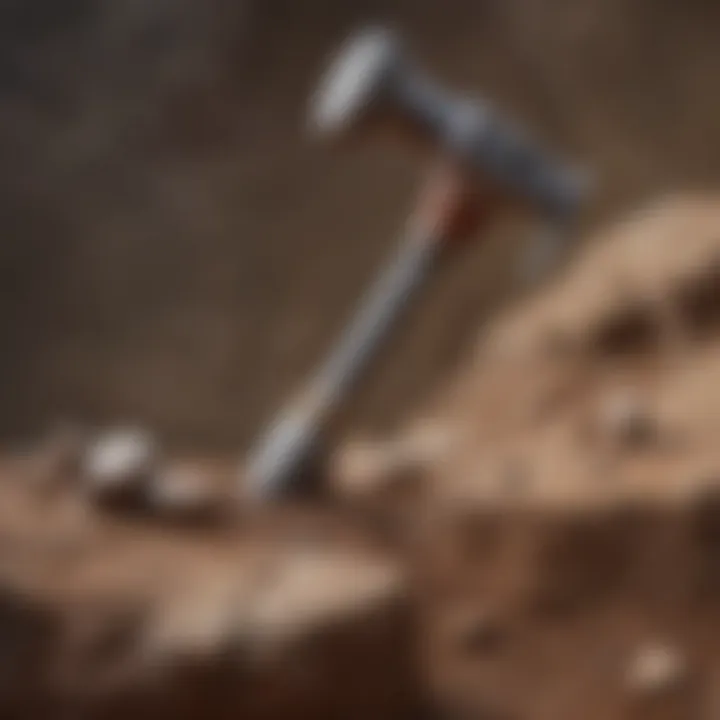The Geology Rock Hammer: An Essential Tool


Intro
A geology rock hammer is more than just a tool for breaking rocks; it plays a pivotal role in the study of earth sciences. For both learners and experienced geologists, understanding this fundamental instrument is crucial. With its unique design tailored for geological investigations, the rock hammer facilitates the process of collecting and analyzing rock samples.
Its applications range from fieldwork in remote locations to educational settings, where it is often used to teach the next generation about mineralogy, petrology, and paleontology. As such, its design considerations, types, uses, and maintenance cannot be overlooked. In this article, we will explore the layers of significance that the rock hammer holds, revealing how it remains an essential element of any geologist's toolkit.
Featured Collectible of the Month
Overview
The geology rock hammer stands as a symbol of exploration and discovery in the field of earth sciences. This section highlights a specific collectible that embodies these qualities. Each month, a unique rock hammer will be featured, focusing on its design, craftsmanship, and the story it tells about its place in geological history.
Historical Significance
The history of the geology rock hammer traces back to its utility in the field. Initially, it was a tool of necessity for miners and early geologists who needed reliable instruments to gather rock and mineral specimens. Over time, the design evolved, integrating ergonomic features and durable materials, responding to the demands of more rigorous fieldwork.
"The rock hammer not only aids in collection but also tells tales of the regions explored and the geological formations encountered."
Identification Techniques
Visual Characteristics
Identifying a rock hammer involves looking for specific visual cues. Key features include:
- Head: The head typically has two primary surfaces: a flat striking face for breaking rocks and a chisel or pointed end for prying.
- Handle: Often made from wood or fiberglass, the handle should be comfortable and sturdy, providing good grip.
- Weight: A well-balanced rock hammer can significantly affect its usability, so examining its weight in relation to the head size is crucial.
Resources for Identification
For those interested in further exploring geological tools, several resources can be beneficial:
These platforms provide valuable insights and community discussions surrounding rock hammers and their usage in geological studies.
Prologue to the Rock Hammer
The geology rock hammer serves a critical role in the practice of earth sciences. Its importance goes beyond mere utility; it is a tool that embodies the intersection of practicality and scientific exploration. For geologists and fossil collectors, having the right hammer is not just a matter of convenience but a necessity to achieve accurate work and to preserve important geological specimens.
Definition and Purpose
A geology rock hammer is specifically designed for a variety of functions in field studies. Primarily, it is utilized for collecting rock samples, breaking samples apart, and exposing fossilized materials that may be hidden within hard rock layers. Unlike traditional hammers, a rock hammer is generally lightweight and often equipped with a flat, chisel-like end for splitting rocks, while the other end is usually pointed for piercing or prying. Its ergonomic design helps minimize fatigue during prolonged use in outdoor settings.
"The rock hammer is not merely a tool; it is a vital component of geological discovery."
The purpose of a geology rock hammer extends to educational settings as well, aiding in demonstrations and practical learning experiences for students studying earth sciences. Understanding how to utilize this tool effectively is crucial, as improper use can lead to diminished sample quality or even personal injury.
Historical Context
The history of the rock hammer dates back to early geological exploration. Initially, simple tools like stones and crude implements were employed by early scientists to study rocks. With the advancement of geology, the need for more specialized tools emerged. By the 19th century, rock hammers began to be standardized, reflecting the growth in geological research and the increasing need for accurate and reliable fieldwork tools.
As geology evolved into a systematic science, so did the design of rock hammers. Modern designs feature durable materials such as steel and composite handles to offer greater strength and stability. Over the years, manufacturers have developed various types of hammers tailored to specific geological tasks, enabling professionals and enthusiasts alike to better meet their unique requirements in the field.
The geology rock hammer has transcended its original design purpose, becoming a sybol of scientific endeavor and exploration. Whether one is a professional geologist or a passionate collector, understanding the rich history and purpose of this essential tool enriches the use and relevance it holds in contemporary earth sciences.
Types of Geology Rock Hammers
Understanding the various types of geology rock hammers is essential for anyone engaged in earth sciences or fossil hunting. Each hammer has distinct features tailored to specific tasks, contributing to both effectiveness and safety in fieldwork. Selecting the right hammer can significantly enhance the experience of collecting samples or breaking rocks while minimizing the risk of injury. This section discusses the four primary types of geology rock hammers, each with its unique applications and advantages.
Claw Hammer


The claw hammer is one of the most recognizable rock hammers in geology. Its dual-ended design features a flat hammer surface on one side and a claw on the other for extracting nails. In geological work, the flat side allows for precision in striking and breaking rocks, making it suitable for collecting smaller samples. The claw side can assist in prying apart rocks or removing material from crevices, providing versatility.
This type of hammer is particularly favored by novice collectors who appreciate its lightweight and easy-to-handle design. Additionally, the claw hammer is accessible and often found in general hardware stores, making it a convenient choice for those new to geological fieldwork.
Chisel Hammer
Chisel hammers possess a flat-edge head designed specifically for chiseling into stone. This hammer is beneficial when working with harder rocks, as it allows the user to strike precisely and apply focused force. The sharp edge can help initiate fractures or remove thin layers from rock surfaces effectively.
Geologists often rely on chisel hammers in combination with chisels to achieve the desired outcome in rock preparation. Their robustness ensures they can withstand significant impact, providing longer life in challenging environments. When detail-oriented work is required, this hammer is a staple in the professional’s toolkit.
Hammer and Pick
The hammer and pick design combines two tools into one, making it extremely versatile for geological applications. The flat hammer end is suitable for normal striking tasks, while the pointed pick end helps in breaking open harder materials and digging into sediment layers. This duality is especially useful in exploration missions where various rock types and conditions are encountered.
While this hammer is heavier than a claw or chisel hammer, its functionality increases its overall value. Many experienced geologists prefer using the hammer and pick for extensive fieldwork, as it equips them to handle a range of situations, from extracting fossils to clearing rubble.
Specialty Hammers
Specialty hammers cater to more specific needs within geology. These can include detailing hammers or geologist's hammers, designed for certain types of work or material. For instance, some hammers may have a larger or narrower head, which could be more effective for working with particular types of rock. Others may feature a textured handle for improved grip and precision.
Field professionals often invest in specialty hammers to enhance their ability to perform certain tasks with greater efficiency. Using these hammers can lead to improved techniques in sample collection or fossil extraction, owing to the tailored design that caters to specific geological processes.
Using the right type of rock hammer can greatly improve efficiency and safety in geological tasks.
In summary, the selection of a geology rock hammer should consider the specific types available and their aligning benefits. Each hammer serves its purpose whether it’s for simple sampling or complex detailed work in the field. Understanding these tools will ensure that both amateur and seasoned collectors can make informed choices suitable to their needs.
Important Features of a Rock Hammer
Selecting the right rock hammer is fundamental for effective geological work. Understanding the features of this essential tool can significantly impact both its performance and the safety of the user. In the field of earth sciences, the significance of specific elements such as material composition, weight, and grip design cannot be overstated. These characteristics play a crucial role in determining how well a hammer will function in various geological conditions.
Material Composition
The material composition of a rock hammer is essential for durability, performance, and efficiency. Most rock hammers are made from steel or other metals due to their strength and resilience. Steel offers both hardness and tensile strength, which are crucial when striking rocks. Carbon steel is a popular choice because it is robust and can withstand heavy use. Some hammers also incorporate high-carbon materials to enhance their hardness, making them resistant to deformation.
On the other hand, hammers with alloy steel can provide a balanced combination of strength and weight. The choice of materials directly influences how a rock hammer performs across different geological formations. For instance, soft sedimentary rocks may require different hammer compositions compared to harder igneous rocks. Therefore, considering material composition allows geologists and fossil collectors to choose tools that will suit their specific needs in various environments.
Weight Considerations
The weight of a rock hammer significantly affects its usability and efficiency. Generally, rock hammers range from six ounces to over a pound. Heavier hammers can deliver more force, which is ideal for breaking tough rocks. However, excessive weight may lead to user fatigue, especially during prolonged fieldwork. Conversely, lighter hammers are easier to handle and reduce the risk of strains, making them suitable for delicate fossil collection where precision is paramount.
When selecting a hammer, individuals should consider not only their personal strength and stamina but also the types of work they intend to carry out. For example, if the goal is to collect fossils from a fragile environment, a lighter hammer might be more appropriate. On the other hand, exploration of rocky terrains may call for a robust option. Understanding the impact of weight helps the user make informed decisions tailored to their specific geological tasks.
Grip Design
The grip design of a rock hammer is another vital feature. A well-designed grip enhances control, reduces slippage, and offers comfort during prolonged use. Most rock hammers come with rubber or textured handles, which provide a better grip, especially in wet or sandy conditions. Ergonomically designed grips can minimize hand fatigue, making it easier to swing the hammer for longer periods without discomfort.
Additionally, grip length and diameter also matter. A grip that fits comfortably in the hand allows for better manipulation and precision during collection activities. Grips that are too large or too small can lead to mishandling and potential accidents in the field. Therefore, a good grip design not only supports effective use but also contributes to the overall safety of the collector. In summary, focusing on the grip design can enhance accuracy and minimize risks associated with the use of geological hammers.
Selecting the right rock hammer depends on understanding its design features such as material composition, weight, and grip. Each aspect influences performance and user safety.
Selecting the Right Rock Hammer
Choosing the appropriate rock hammer is fundamental for both efficiency and safety in geological fieldwork. This decision impacts how effectively one can gather samples, break rocks, and explore geological sites. Each hammer has unique characteristics that cater to varied tasks, making selection critical for optimal performance.
Factors to Consider
Several dimensions need to be evaluated when selecting a rock hammer:
- Type of Work: Determine if you need a hammer for sampling, breaking rocks, or specific geological tasks. Different designs, like claw or chisel hammers, serve specific purposes.
- Material Composition: The construction material of the hammer affects its durability and weight. Hammers made of forged steel typically provide a balance between resilience and performance.
- Weight: Heavier hammers provide more force but can lead to fatigue during extended use. A lighter hammer is easier to handle but may require more effort to break tougher rocks.
- Grip Design: Comfort during use is crucial. A well-designed grip can prevent slipping and reduce hand strain.


Field Conditions
Field conditions strongly influence the choice of a rock hammer. Factors that come into play include:
- Environment: If the terrain is rocky or uneven, a hammer with a robust handle could offer better stability and control.
- Weather: In rainy or humid environments, hammers with anti-corrosive materials will be more effective and longer-lasting.
- Portability: For hiking or extensive fieldwork, a lightweight hammer is better suited and less cumbersome.
Personal Preference
Selecting a rock hammer is not merely a technical decision; personal preference also plays a crucial role. Here are considerations:
- Familiarity: Using a hammer that feels comfortable and familiar can enhance efficiency and confidence in the field.
- Aesthetic Choices: While functionality is key, some users prefer hammers with designs or colors that resonate with their personal style.
- Feedback: Engaging with fellow rock and fossil collectors can provide insights into choices. Recommendations from trusted sources can also guide individuals in their selection.
Choosing the right rock hammer must be a well-considered decision. By examining these factors, aspiring geologists and collectors can find a tool that meets their specific needs, ensuring both effectiveness and enjoyment in the exploratory processes.
Using a Geology Rock Hammer Safely
Understanding the proper use of a geology rock hammer is crucial for both novice and experienced geologists. Safety is paramount, as the misuse of this tool can lead to injuries. A geology rock hammer can become a dangerous tool if not handled correctly. Thus, it is essential to follow specific safety measures that ensure the well-being of the user and those nearby. This section will discuss personal protective equipment, proper techniques, and common hazards associated with using a geology rock hammer in the field.
Personal Protective Equipment
When engaging in geological fieldwork, wearing the right personal protective equipment (PPE) is vital. PPE serves as the first line of defense against potential injuries. The following items are recommended:
- Safety Goggles: Protects your eyes from flying debris when striking rocks.
- Hearing Protection: Useful when working in confined spaces or near others using hammers.
- Sturdy Gloves: Offers grip and protects hands from sharp edges or rough surfaces.
- Steel-toe Boots: Prevents injuries from dropped tools or heavy rocks.
By utilizing the appropriate personal protective equipment, you reduce the risk of injuries significantly. Particularly in areas where loose rocks are prevalent, such protection becomes even more crucial.
Proper Techniques
Using a geology rock hammer involves more than mere strength. Employing proper techniques maximizes efficiency while minimizing the risk of injury. Here are some essential techniques to consider:
- Grip: Hold the hammer firmly but not overly tightly. A proper grip allows better control.
- Stance: Stand with feet shoulder-width apart. This stance provides stability, especially when working on uneven ground.
- Aim: Carefully aim before striking. Focus on the intended target to avoid ricochets.
- Control: Use swift, controlled motions rather than heavy blows. This approach prevents excessive force that could lead to slips or misstrikes.
Following these techniques will ensure that your strikes are calculated and effective, reducing the likelihood of accidents.
Common Hazards
While using a geology rock hammer, various hazards can arise. Awareness of these hazards is crucial for safe operation. Some common hazards include:
- Flying Debris: Fragments from struck rocks can become projectiles.
- Rock Falls: Loose rocks can fall unexpectedly, particularly when in mountainous or hilly areas.
- Strained Muscles: Improper use can lead to muscle strains; thus, warming up is advisable before prolonged activity.
- Cuts and Bruises: Always be cautious of sharp edges on rocks, as they can cause injuries.
By being conscious of these hazards, you can take effective preemptive measures. For example, ensuring a clear working area and communicating with colleagues helps in minimizing risks associated with flying debris.
Safety is not just a part of the process; it should be the foundation of your geological explorations. Protect yourself and others to make the most of your fieldwork experience.
Field Applications of a Rock Hammer
The field applications of a rock hammer are fundamental to understanding geology and paleontology. This tool serves several key purposes during fieldwork, enabling geologists to both gather information from rock formations and to effectively study them. Not only does the rock hammer aid in sample collection, it also assists in the examination of geological structures. The versatility and efficiency of the rock hammer make it indispensable in various field applications.
Collecting Samples
Rock hammers play a pivotal role in sample collection. Geologists often seek specimens that provide clues about the past environments and to understand mineral compositions. With the right technique, a rock hammer allows for precise extraction of rock samples without damaging them excessively. The method used in sample collection directly influences the quality of specimens collected. When choosing a hammer for this purpose, one must consider the type of rock, as harder materials may require a heavier hammer, while softer substrates need a lighter touch. Additionally, ensuring the sampled rock has minimal weathering preserves its integrity.
Breaking Rocks
Another significant application of a rock hammer is breaking rocks. This task is often necessary to access fossilized remains or minerals hidden within larger boulders. The force exerted by a rock hammer can crack rocks along natural lines of weakness, allowing for more effective exploration. While breaking rocks, safety must not be overlooked. It's essential to stand clear of debris and wear protective gear. Proper technique reduces the risk of injury and ensures a clean break, increasing the value of retrieved samples. When using a rock hammer for breaking rocks, it’s crucial to strike with control and precision.
Site Exploration
Site exploration is a critical aspect of geological fieldwork. A rock hammer aids geologists in evaluating rock formations and assessing the geological history of a site. By removing samples and examining rock layers, professionals can gather essential information about the geological processes that shaped an area. Careful observation and analysis during site exploration contribute to understanding the earth's structure. The versatility of the rock hammer allows geologists to work in various environments, from fragile outdoor quarries to urban settings. Collecting data in these contexts can reveal much about both ancient and contemporary geological activities.


"The rock hammer is not simply a tool; it is a key to unlocking the stories trapped within the earth."
In summary, the field applications of a rock hammer encompass vital processes such as sample collection, rock breaking, and site exploration. Each function is important for gathering data and understanding geological formations. For rock and fossil collectors, mastering these techniques enhances their ability to contribute valuable insights to the field.
Care and Maintenance of a Rock Hammer
Maintaining a rock hammer is essential for prolonging its lifespan and ensuring optimal performance during fieldwork. A well-cared hammer can contribute significantly to efficiency, safety, and precision when handling geological samples. Understanding cleaning methods and proper storage procedures will enhance the reliability of this important tool. The following sections will explore these aspects in detail.
Cleaning Procedures
Cleaning a rock hammer after use is crucial to prevent corrosion and damage. Geologists often work in harsh conditions, where dirt, moisture, and residues can accumulate on the hammer's surfaces. To clean the hammer effectively:
- Remove any debris immediately after use. This includes dirt or any rock fragments stuck to the hammer.
- Wash with water using a cloth. For stubborn stains, a soft brush can help loosen grime without scratching the metal.
- Dry thoroughly before storage to avoid rusting. This is particularly important if the hammer has been exposed to water.
- Apply a light coat of oil on the metal surfaces. This will provide a protective barrier against moisture and help in maintaining its condition over time. Use products like mineral oil or machine oil, which are effective and safe for metal tools.
Regular cleaning will not just keep the hammer in good shape; it also ensures that the collector does not inadvertently contaminate samples with dirt or residue from previous explorations.
Storage Recommendations
Proper storage of a rock hammer will protect it from damage and ensure that it remains in optimal condition between uses. Here are some guidelines on how to store the hammer effectively:
- Keep in a dry place. Moisture can lead to rust, which is damaging to metal tools. Ensure that the storage area is well-ventilated.
- Use a protective case. A carrying case or sheath not only provides protection but also makes transportation easier. Consider a case that has a hard exterior to guard against impacts.
- Avoid stacking heavy items on top. This could distort the hammer or cause the handle to become misaligned.
- Store upright if possible. This minimizes pressure on the hammer’s components and can help prevent bends or breaks.
By following these care and maintenance practices, geologists and collectors can extend the life of the rock hammer and ensure it remains a reliable tool for their geological endeavors. Keeping the hammer clean and stored properly will enhance not only its longevity but also improve the user's experience in the field.
Implications in Collecting and Fossil Hunting
The field of geology and paleontology heavily relies on effective collection techniques. A geology rock hammer facilitates sample collection and fossil hunting, which are vital activities for both amateur enthusiasts and professionals. Grasping the implications of using this tool can enhance the quality of findings while ensuring compliance with relevant laws and guidelines.
Enhancing Collection Techniques
Using a geology rock hammer can significantly improve collection efficiency. The right hammer allows collectors to carefully extract samples from rock formations without causing unnecessary damage. Here are some benefits of incorporating rock hammers in collecting techniques:
- Precision: A well-designed rock hammer can provide better control when striking rocks. This helps in targeting specific areas, thereby increasing the chance of uncovering well-preserved fossils.
- Versatility: Different types of rock hammers, such as claw and chisel hammers, offer various functionalities. Each type serves unique purposes, enabling collectors to adapt their techniques based on the nature of the site.
- Safety: A rock hammer can reduce the risk of injury when used properly, as it allows for more deliberate and controlled movements compared to other methods.
"Effective collection practices begin with the right tools. A geology rock hammer is essential for minimizing damage to both the sample and the site."
Legal Considerations
When engaging in collecting and fossil hunting, it is crucial to be aware of the legal landscape. Many areas have regulations governing the removal of geological specimens and fossils. Ignoring these regulations can result in legal repercussions. Here are some important considerations:
- Permits: Always check if a collecting permit is required in your area, especially in parks or protected lands.
- Ownership Rights: Understand the ownership laws pertaining to fossils and rocks. Many sites have specific rules on what can be collected and who it belongs to after removal.
- Environmental Impact: Consider the potential environmental effects of collecting activities. Engaging in responsible practices helps preserve ecosystems while allowing for valuable geological studies.
By recognizing the implications of using a geology rock hammer for collecting and fossil hunting, enthusiasts can both enhance their practices and comply with legal standards.
Ending: The Rock Hammer's Role in Geology
The rock hammer stands as a cornerstone within the field of geology, embodying both functionality and practicality. Its significance transcends mere physical utility. It acts as a bridge facilitating the relationship between the field and theoretical knowledge. For the earth sciences, understanding the geology rock hammer encompasses an array of specific elements that illuminate its benefits.
Firstly, the creation of geological samples is heavily reliant on this tool. The ability to carefully and accurately collect rock samples allows for further analysis in laboratories. Without the right hammer, the potential for obtaining quality specimens decreases. This directly impacts the research quality in geology and paleontology. Moreover, rock hammers encourage exploration, prompting both amateur rock collectors and seasoned geologists to venture into less-traveled terrains.
When considerations arise regarding the design and selection of rock hammers, it is crucial to acknowledge the variety that exists. Different types serve unique purposes, tailored to address specific geological contexts. A well-informed choice enhances not just safety but also efficiency during fieldwork. The hammer thus becomes an essential ally, translating the complexities of geology into manageable tasks.
"In the hands of a skilled geologist, a rock hammer is not just an instrument but an extension of one’s understanding of the earth's history."
Final Thoughts
As we reflect on the expansive role of rock hammers in geology, it is essential to consider their educational implications. Training the next generation of geologists involves familiarizing them with the nuances of proper rock hammer use. This education extends into various environments, where each geological formation presents unique challenges. Building a foundational understanding of how to use the rock hammer safely and effectively can influence future geologic explorations immensely.
Additionally, enhancing community engagement through local geology clubs and organizations can foster a deeper appreciation for this essential tool. Sharing experiences and knowledge among peers contributes to a more cohesive understanding of geology.
Future Trends
Looking ahead, the evolution of rock hammer designs may lead to advancements that incorporate modern materials and ergonomic principles. Enhanced durability and grip are likely to become focal points for manufacturers. Considering the popularity of field work, integrating technology with traditional tools could also emerge. For instance, incorporating lightweight materials or smart features might attract younger enthusiasts into geology.
Furthermore, discussions surrounding sustainability are necessary. As interest in geology rises, ensuring that rock hammers are manufactured in eco-friendly ways becomes paramount. Research and innovation in sustainable materials may shape the future landscape of geological tools.
Overall, the rock hammer will continue to play a pivotal role, driving curiosity and understanding in the earth sciences.



